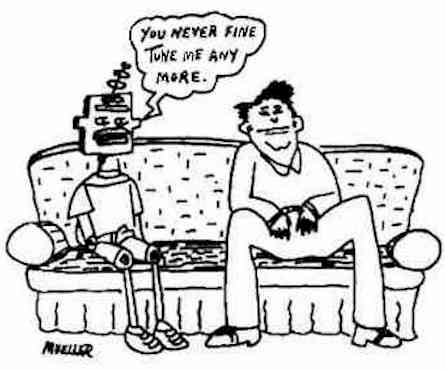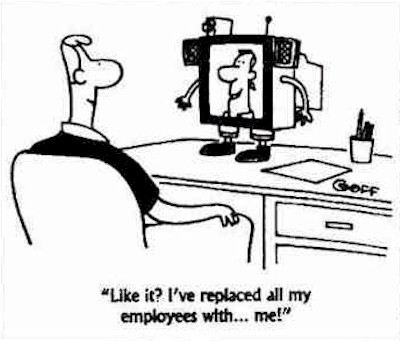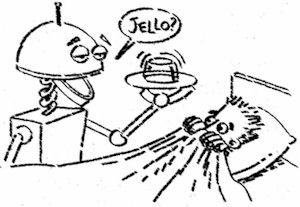Ro Ro Ro Your Bot
Are You Wearing a Life/Jacket?
- Isaac Asimov The following article takes a more light-hearted look at essentially the same idea as did the author of Yearning to Be a Nobody.
Robots Ate My Shoesby Raymond Lesser At 6:30 am my clock radio turns on to a Bach concerto, and my bed begins to transform itself into a bathtub. Soon the tub is filled with hot water and wash-bots have attached themselves to my feet and begun my morning scrub, shave, and hair enhancement. At 7:00am I am dried and returned to an upright, seated position at my table, where the botler brings in coffee and breakfast, which consists of an organic fruit salad, and fresh baked rolls with Full Enlightenment nutritional spread and apricot anti-depressant jam. While I am being spooned bites and sips, I survey the morning news scan for the latest updates. Because of increased threats from terrorists, Congress is recommending a new law which would restrict movements of all non-delivery robots to their owner's buildings after 10pm each night. I vote for this issue because I think it's a worthwhile amendment to the Anti-Terrorist Act of 2034, which instituted a 3-day waiting period for any robot wishing to buy a handgun. If it passes, the law will go into effect as soon as all the after-hours robot strip clubs and body shops have been shut down. After breakfast my chair converts itself into a robotic toilet, and a waste removal bot inserts itself to vacuum and polish my large intestines. Simultaneously, a medical bot does a complete scan of all my vital functions. It adjusts the dosages on my 23 prescription drugs and 34 vitamin, mineral, and brainwave supplements, and recommends I begin taking Big Shot, a new multi-drug which can increase my sense of self-importance by an average of 6.2%. Then my personal trainer-bot straps me into the simulator and I am led through my daily workout tape, a series of real-life simulations which, with the help of memory enhancements, give me the opportunity to win an Olympic gold medal in the men's decathlon, perform as the prima ballerina in Swan Lake, and break the speed record in the Kentucky Derby as the winning horse. After a rubdown with liniment, my botler dresses me and I am ready for work. I log on and download today's projects, which consist of several customer satisfaction surveys, a quiz about advertising image retention, and participation in a focus group comparing five potential hosts for a talkshow about houseplants.
Soon it's time for my weekly lunch with the bridge club. I go into the virtual dining room where I am served the perfect rations for my irrigational needs, and I can talk and interact with holographic projections of three friends, each doing the same thing in their dining rooms in Boston, New York, and Miami. After lunch we while away the afternoon playing cards and discussing the latest gossip about the President and his latest sexual escapades with pirated versions of movie star clones procured by the Chinese. The younger children come home from school and we have dinner and visit. Of course, because of the Population Stabilisation Act of 2025, all of my children are virtual simulations based on my DNA combined with the DNA of various famous people I've fallen in love with over the years. In addition to the never-ending doting attention they get from the family bots, my kids are thoroughly monitored and rigourously tested by the Central Education Authority, and are trained just as though they were biological children. If they can continue receiving high grades they will get the opportunity to be reborn and reeducated. My oldest son was recreated as an associate professor bot at the University of Wisconsin. He probably could have become a human professor, but those positions were eliminated when he was still a junior at Virtual Harvard. Not that I love him any less because he didn't make it into human form. Besides, with his intellect and reliability, he has a chance to be tenured for the next 900 years. When the kids go off to do their homework and play their computer games I begin cruising my favourite relationship sites. I download my life and say whatever is on my mind and the sitetender finds me a perfect match, or at least the most perfect match that's available for that moment. We drink, talk, share a webcast together, have sex if we're in the mood, and then, if things are going really well, maybe even go to sleep and share a dream. The 21st century is an amazing time to live. For those of us who are linked together in the safety of out homes there is no longer any danger of disease, physical violence, or rude cab drivers. Our low impact, low stress lifestyle has helped eliminate the threat of starvation, environmental devastation, and bad dates. Our fantastic technological advances give us plenty of time, as well as the physical health and mental clarity to pursue a worldwide web of interests. Truly I live in the best of all possible worlds. Even if my door was unlocked from the outside, I'd have no desire to ever go anywhere else. Source: Funny Times February 2000 See also:
Source: Funny Times February 2000
Go Away, Dear Kismet; You're Not MY Kismetby Patricia Pearson Tourists now visiting Boston can pop into the Massachusetts Institute of Technology, if they're so inclined, and check out an exhibit called, "Robots and Beyond: Exploring Artificial Intelligence at MIT." Among the other mechanical marvels on display is Kismet, a sociable humanoid robot who looks like a scrap heap with big Mickey Mouse eyes. Kismet is about as humanoid as my dishwasher, but the robot has a flexible rubber mouth stuck to its wires and widgets that can smile, frown, purse in disgust and open wide in surprise. According to MIT's website, Kismet has been designed to perceive "a variety of natural social cues" through "natural and intuitive social interaction with a human caregiver." You have to think the programmers are getting a bit carried away, referring to a machine powered by 15 computers as an object in need of a "caregiver." I could run over it with my Volvo and it wouldn't even notice. Still, the whole programming effort is modelled on infant development, with Kismet designed less to perform a specific task - such as lumbering around on Mars or lurching down mine shafts - than to be a blank slate that can learn emotional and social behaviour by interacting with the environment. Now, for me, the question arises: Do we really have to have sociable humanoid robots? Don't we have any friends? Are we not getting along with our mothers? Did our beloved Siamese cat die, and we hope to replace her companionship with an object that can get whacked by a speeding Volvo and still smile? MIT makes vague references to Kismet's usefulness in the "domestic, entertainment and health care" fields. This would make sense, given that the project is being funded by the Office of Naval Research. Who, if not sailors, need sociable humanoid robots to tidy their bunks, put on entertaining little plays and hand out tablets of Gravel to the nauseous? Or does the Navy have something else in mind? Maybe it wants sociable humanoid robots that can scream, "Oh no!" and open their mouths in surprise as the submarine they're steering ploughs into a fishing trawler. Nothing like a gaggle of repentant robots with down-turned mouths to take the heat at some future congressional hearing. "Bad. Kismet, bad!" "I'm sorry. I misread some environmental cues." Whatever the Navy hopes, you can be pretty sure that Kismet or his kin will eventually find a way into public use in the "domestic, entertainment and health care" fields. The PR guys at MIT argue that "building systems that can exploit and understand social cues could make machines easier for people to use and enable humans to communicate with machines in richer ways." You know, this is the sort of justification that makes my skin crawl. Basically, the geeks at MIT just want to see whether they can pull it off that's all. They don't care whether industry appropriates the technology to replace human beings with totally inadequate but more "cost-effective" substitutes. Granted, certain HMO bureaucrats and customer service reps behave like robots, but at least I can try to inflict pain on them when I'm at the end of my tether by insulting them if I can. There is no prospect of that with machines. My bile rises every time I phone information these days and get a generic, recorded female voice commanding me to blurt out my request in digestible bits. God forbid I should say: "I'm looking for a new listing for Joe Camel, but I'm not sure if he's on..." "What city, please?" the voice interrupts, totally uninterested in ambiguity or pleas for help, not to mention the fact that I happen to be talking. The experience disturbs me because it forces me to communicate like a machine, with mechanical precision, at the behest of a machine. It dehumanises me. So what is Mr Sociable Personality Kismet going to accomplish in this situation? Will it sense my explosive frustration and look sad? Will it invite me to communicate more humanely? Oh, well then, yea for me. I'll feel about as dignified as a psychotic person gabbling at a tree. "Ya see, Kismet, I have this problem, and I know you're the sort of inanimate object that understands how things are."
Perhaps the scholars at MIT haven't come across the psychological literature on this, but the reason such psychopaths as Timothy McVeigh horrify us so much is that they appear to be human, but aren't. They read our social and emotional cues and respond appropriately when it suits them. When it doesn't, their inhumanity comes roaring out like a demon. They feel neither empathy nor compassion nor love. They do not care. And neither does Kismet. So who, exactly, stands to benefit from a deceptively humane machine? MIT's scholars haven't thought through all of the implications yet, as they cheerfully concede themselves on Kismet's Web page. Would they kindly do so before I grow old? Patricia Pearson, a freelance writer in Toronto, is a member ofUSA Today's board of contributors. Source: USA Today Wednesday 6 June 2001 illustration by Sam Ward
For articles on bacteria, centrioles, chairs, nebulae, asteroids, robots, memory, chirality, pain, fractals, DNA, geology, strange facts, extra dimensions, spare parts, discoveries, ageing and more
click the "Up" button below to take you to the Index for this Science section. |
 Animals
Animals Animation
Animation Art of Playing Cards
Art of Playing Cards Drugs
Drugs Education
Education Environment
Environment Flying
Flying History
History Humour
Humour Immigration
Immigration Info/Tech
Info/Tech Intellectual/Entertaining
Intellectual/Entertaining Lifestyles
Lifestyles Men
Men Money/Politics/Law
Money/Politics/Law New Jersey
New Jersey Odds and Oddities
Odds and Oddities Older & Under
Older & Under Photography
Photography Prisons
Prisons Relationships
Relationships Science
Science Social/Cultural
Social/Cultural Terrorism
Terrorism Wellington
Wellington Working
Working Zero Return Investment
Zero Return Investment I finish quickly, which gives me time to do a little shopping before lunch. The bots take care of all the buying of
food and supplies, and my apartment is already crammed with the latest versions of everything i want, but my bots have been looking a little drab lately so I order a new red jacket and tie for my botler,
and a couple of pastel smocks for the cleaning bot. They've also been complaining that I don't give them nearly as much work as they were designed to handle, so I download a Mars Base work
simulation program, so that they can keep their adventuring circuits engaged at peak efficiency. And, who knows, maybe someday they'll be able to transfer to a space station. Anything is
possible for a young bot with enough ambition.
I finish quickly, which gives me time to do a little shopping before lunch. The bots take care of all the buying of
food and supplies, and my apartment is already crammed with the latest versions of everything i want, but my bots have been looking a little drab lately so I order a new red jacket and tie for my botler,
and a couple of pastel smocks for the cleaning bot. They've also been complaining that I don't give them nearly as much work as they were designed to handle, so I download a Mars Base work
simulation program, so that they can keep their adventuring circuits engaged at peak efficiency. And, who knows, maybe someday they'll be able to transfer to a space station. Anything is
possible for a young bot with enough ambition.
 I don't want this. I don't want to be in a nursing home when I'm 90 and have Kismet amble over in a crisp, white
dress and offer me Jello and pretend to care. I don't want Kismet to be my bartender. I don't want Kismet to put on a puppet show. I don't want Kismet to clean my toilet. I don't
want Kismet to be my kismet; I want it to go away.
I don't want this. I don't want to be in a nursing home when I'm 90 and have Kismet amble over in a crisp, white
dress and offer me Jello and pretend to care. I don't want Kismet to be my bartender. I don't want Kismet to put on a puppet show. I don't want Kismet to clean my toilet. I don't
want Kismet to be my kismet; I want it to go away.